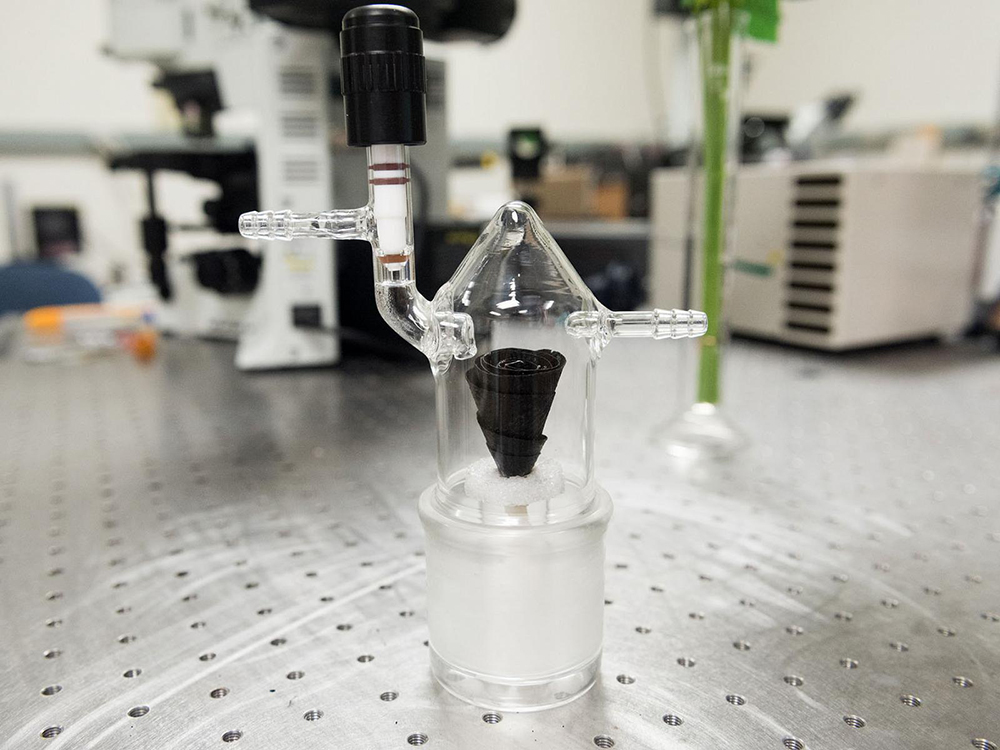
Nanomaterials consist of microstructural features (grains, domains, phases, precipitates, etc.) that range in size from 1 – 100 nm. At this scale, many materials exhibit properties that differ from their bulk-sized analogues. The ability to tune the properties of materials by controlling size allows nanomaterials to have applications in a broad range of fields including optics, magnetic devices, catalysis, microelectronics, pharmaceutics, and energy conversion and storage technologies. The University of Texas at Austin has strong expertise in the synthesis, characterization, property measurements, and performance evaluation of nanomaterials as well as devices based on nanomaterials.
Associated Graduate Program Faculty
Guihua Yu
Nanostructure-enabled energy storage and conversion devices; self-assembled nanosystems for flexible electronics and optoelectronics; hybrid inorganic-organic nanomaterial systems for functional interfaces with biological systems.
Yuebing Zheng
Nanoscience and nanotechnology at the interfaces of photonics, fluidics, and molecular engineering. Interactions between light and matter at the nanoscale; nanomaterials and nano devices for disease diagnosis and therapy and solar energy; Molecular Motors, Molecular Plasmonics, and Plasmofluidics.
Jianshi Zhou
Design and synthesis of new electronic materials including superconductors, spintronic/orbitronic materials, thermoelectric materials, multiferroic materials and magnetoresistive materials.
Donglei Emma Fan
Fabrication, characterization, manipulation, and assembly of metallic, semiconductor, magnetic, and composite nanowires, nanorings, and nanoporous networks and their applications in nanorobotics, electronics, biology, and energy fields.
Tanya Hutter
Emerging molecular sensing technologies, materials, methods and devices for applications in environmental and industrial sensing, homeland security and medical diagnostics; nanomaterials, microfabrication, surface chemistry, nanophotonics, optical sensing, waveguides, fiber-optics, spectroscopy, electrochemistry.
Desiderio Kovar
Processing and properties of inorganic nanoparticles and nanoparticulate thick films for applications in interconnects, packaging, catalysis, and membranes.
Filippo Mangolini
In situ analytical techniques for investigating oil/substrate interfaces in tribological systems; in situ thermally-induced structural evolution of amorphous carbon surfaces; mechano-chemistry of solid and liquid lubricants.
Arumugam Manthiram
Solution-based chemical synthesis and characterization of metal alloys, metal oxides, and organic-inorganic composites with unique nanomorphologies; nanomaterials and nanocomposites for batteries, fuel cells, supercapacitors, and solar cells.
Li Shi
Theory-guided synthesis and characterization of electronic, thermal, and quantum materials, including bulk crystals, low-dimensional materials, and nanocomposites for (i) heterogeneous integration of next-generation chip architectures, (ii) decarbonization of heat and fuel, thermal energy storage, thermoelectric conversion, and (iii) emerging quantum devices and hardware.
Deji Akinwande
Carbon-based nano electronics, wireless flexible electronics, medical electronics.
Sanjay Banerjee
MOS and nanostructured microelectronic device modeling; heterostructure microelectronic devices; ultra-shallow junction technology and process modeling.
Michael Becker
Processing, characterization, and properties of nanoparticles of gold, silver, silicon, CdSe, GaN, PZT, Terfenol, and related materials for applications in electronic interconnects, linear and nonlinear photonic devices, and micro-mechanical actuators.
Alex de Lozanne
Nanostructures, thin films and devices, high temperature superconductors, and colossal magnetoresistant materials studied with scanning probe microscopy.
John Ekerdt
Surface, growth, and materials chemistry of metal, dielectric, ferroelectric, and polymer films and silicon nanostructures.
Rui Huang
Mechanics of polymer gels and soft materials, two-dimensional (2D) nanomaterials and thin films, thermomechanical reliability of microelectronic devices and packaging, multiscale modeling and simulations.
Gyeong Hwang
First principles-based multiscale modeling; synthesis-structure-property relationship of nanostructured materials; surface and interface chemistry; defect and dopant structure and dynamics; semiconductor processing; fuel cells; electrochemical energy storage.
Keith Johnston
Colloid and interface science, materials chemistry, and nanocomposite materials; biomedical and pharmaceutical nanotechnology; nanotechnology for energy; magnetic/optical nanocrystals for imaging and therapy in atherosclerosis and cancer.
Brian Korgel
Synthesis of nanostructured materials, fabrication of devices based upon these materials, and study of their properties with a focus on investigating size-tunable material properties; rational self-assembly and fabrication of nanostructures with atomic detail; applications including microelectronics and photonics, spintronics, coatings, sensors, and biotechnology.
Wei Li
Materials processing and manufacturing, particularly multifunctional nanomaterials, biomaterials, and biomedical micro devices; biomedical micro devices for 3D cell culture and drug delivery, polymer nano foams and nanocomposites for multifunctional applications, nanoporous materials for energy storage, and manufacturing processes for alternative transportation energy.
Kenneth Liechti
Deformation and failure mechanisms in multilayered materials and structures using a combination of experimental and numerical stress analytical techniques; interfacial force microscopy; nano indentation of ultra-thin films and self-assembled monolayers; mechanics of adhesion and friction; interfacial fracture mechanics; experimental mechanics; microelectronics packaging.
Jung-Fu Lin
Novel materials properties (superhard, superconductors, energy storage, two-dimensional materials; new optical, X-ray, and high-pressure techniques for materials analysis.
Nanshu Lu
Mechanics of thin films on compliant substrates, mechanics of flexible electronics with extreme deformability and compliance, mechanics at bio-electronics interfaces, development of novel bio-integrated soft electronics for cardiac, neural and epidermal applications.
Chih-Kang (Ken) Shih
Quantum control of condensed matter systems; engineering materials with atomic precision to control system dimensionalities at different length scales; nanostructures with length scales at which the interplay of electronic, photonic, and spin degrees of freedom result in novel materials properties; semiconductor nanostructures, metallic thin film nanostructures, plasmonics.
Huiliang (Evan) Wang
Development of nanomaterials, organic materials and electronics materials for advanced neurotechnology applications.
Yaguo Wang
Ultrafast optical spectroscopy to detect and control phonon/electron dynamics in thermoelectrics, photovoltaics and interfacial systems for applications in waste-heat recovery, solar cells and batteries; thermal-physical property characterization in nano-devices.
C. Grant Willson
Block Copolymer Nanolithography; Materials for double Exposure Lithography; E-Beam Resists; Immersion Lithography; Non-linear optical Materials.
Edward Yu
Nanoscale imaging and characterization techniques, particularly based on proximal probes; solid-state nanostructure physics and devices.

